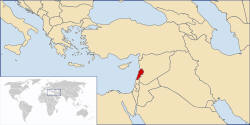لبنان الجمهوريّة اللبنانيّة



٣٥°٣٢′E
رئيس الدولة
رئيس مجلس النواب
رئيس الوزراء
ميشال سليمان
نبيه بري
تمام سلام
من فرنسا
– كامل
– مياه (%)
١٠٤٥٢كم²١٫٦
– توقع 2008
– الكثافة السكاني
٤٫١٩٦٫٠٠٠
٣٥٨\كم²
في الصيف ٣+
المعروف عن المجتمع المدني اللبناني أنه مجتمع استثماري تجاري وسمح انتشار اللبنانيين في العالم في بناء علاقات تجارية عالمية وللبنان نسبة عالية من اليد العاملة الماهرة توازي مستوى الدول الأوروبية، وهي الأعلى بين الدول العربية.
الزراعة
بالرغم من أن طبيعة لبنان مناسبة للزراعة من حيث وفرة المياه والأراضي الخصبة وهي الأعلى نسبة بين البلدان العربية الاسيوية، إلا أن نسبة الاستثمار في الصناعات الغذائية ضعيفة ولا تجذب أكثر من ١٢% من اليد العاملة والناتج من الزراعة لا يتجاوز ١١% من إجمالي الناتج المحلي وهي الأدنى بالمقارنة مع القطاعات الاقتصادية الأخرى. ومن أهم المنتوجات الزراعية اللبنانية هي التفاح، الدراق، البرتقال والحامض والزيتون.
الصناعة
يفتقر لبنان لخامات المواد الأولية الطبيعية ويعتمد على الدول العربية في الحصول على النفط ولهذا فإن إنشاء صناعات انتاجية عملية غير مربحة، لذلك يركز اللبناني على الصناعات التحويلية وإعاده التركيب لمنتوجات مستوردة.
في عام ٢٠٠٤ شغل القطاع الصناعي ٢٦% من اليد العاملة وساهم ب٢١% من الناتج المحلي. من أهم الصناعات: صناعة الأغذية والمنسوجات والكيماويات والإسمنت ومنتجات الأخشاب وتصنيع المعادن والمجوهرات وتكرير النفط، وهناك موارد طبيعية أخرى مثل الحجر الجيري وخام الحديد والملح. من أهم الحرف: صناعة القش والفخار والخزف والزجاج المنفوخ والنحاس والنسيج والخشب، صناعة المرصبان والسكاكين وصهر الأجراس والحلي من الفضة والصابون الحرفي والتطريز.
الخدمات
أهم القطاعات الاقتصادية اللبنانية هو قطاع الخدمات وبخاصة قطاعي السياحة والمصارف. فنظامه الرأسمالي وقانون سرية المصارف المتبعة فيه جذبت العديد من الرساميل. وطبيعة البلاد الجذابة ونشاطاته السياحية والثقافية تجعله منطقة جذب للسياح ويقصده خاصة السياح من الخليج العربي حتى خلال الأزمات. ف٦٥% من اليد العاملة تعمل في قطاع الخدمات ويساهم هذا القطاع ب٦٧٫٣% من الناتج المحلي
في عام ٢٠٠٦، سجلت موجودات المصارف بأكثر من ٧٥مليار دولاركما سجلت حركة السياحة زيادة وصلت إلى ٤٩٫٣% مقارنة بعام ٢٠٠٥ ووصلت قيمة الاستثمار في السوق الى ١٠٫٩%.
الثقافة
قدم تاريخ لبنان وعبور الحضارات على أراضيه وتنوع شعبه يجعله غني يتنوع وغزارة ثقافاته. والمجتمع اللبناني الحالي متطور وحديث ويماثل المجتمعات الأوروبية المطلة على البحر الأبيض المتوسط
*المعلومات من http://ar.wikipedia.org




